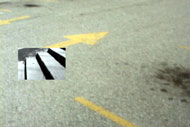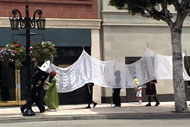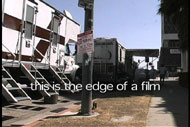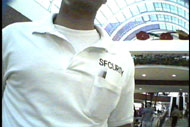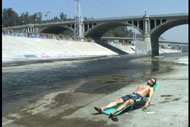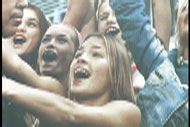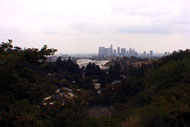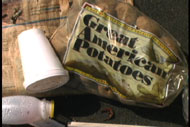 |
July
2002 volume 1, issue 1 |
| |
|
|
|
Interview with A-Clip (continued | 1,
2, 3, 4) Christina Ulke: Is it then only about the newness of the urban issue? What about the goals? Klaus Weber: It was not about achieving a special goal. It was a struggle for symbolic things. Katja Eydel: It was about generating a public discourse, mediating ideas. Klaus Weber: It was about the construction of meaning and the deconstruction of meaning. Katja Eydel: re-evaluation …. Christina Ulke: And then A-clip continued in 1999 but inner city action discontinued? Klaus Weber: During the inner city action 98 we didn’t do another A-clip series. We decided to split it. It was much more comfortable for the film producers because they didn’t have the double pressure of being an activist and a film producer. 1999 we did another round of A-clips. But it wasn’t called anymore "A-clip for inner city action". Christina Ulke: Hearing how A-clip is tied to a particular moment in Berlin, why did you want to bring it to New York and Los Angeles? Klaus Weber: During the time we started with inner city action, a lot of urban theories were imported from the US; the "broken window theory ", the "zero tolerance theory", the "cleansing of NY city theory". Guiliani’s strategy was used as a tool in German mainstream media. Even the German Minister of Inner Affairs went to NY, took a NY Police Department cap and had a picture taken with the NYPD. When he came back to Germany he announced, "We will do the same thing, it is very effective." Katja Eydel: Everybody who is involved in the project can talk about the project and people do so. The idea gets around…. At one point I was at the symposium in NY in 1999. I had the feeling that talking about our methods and activities got so much attention in the US…. it was — wow - strange because these practices we were using came originally from the US. So 10-15 years later, people in NY say, "well, we have all these strange developments in NY, we can’t recognize the city anymore — hey, that’s cool what you are doing in Berlin". Christina Ulke: How do you think your practice was influenced by the US? Katja Eydel: We were discussing a lot of the conceptual art - all these very old groups; Paper Tiger, Group Material for example. We were looking at their strategies as a model. It was funny, we kind of brought the message back to the prophet. Klaus Weber : A-clip LA and A-clip NY are just attempts. If it happens organically that’s good. Katja Eydel: The big problem is if you produce films for the cinema you have to copy the material on 35 mm film, which is really expensive. For the 1st A-clip series we had about 13,000 dollars, which we spent on the technical stuff. It’s not like you can say "let’s do another A-clip", you always have to find the money to pay for the transfer this work which makes it difficult. We never did anything professionally. We don’t know where the films went, people just brought them into cinemas, we don’t remember which cinemas. The films disappeared, we had something like 200 film reels, and now we only have 15. No one knows where they are. A-clip was never run strictly, it was always loose. Also the margins were loose, there is no corporate strategy. Somehow things function on a voluntary basis. But the money thing is different, you have to invest a lot of effort, this is when the boat tips over to one side. Klaus Weber: Often times the volunteership was very abstract. In the case of distribution, films were distributed from one projectionist to another. Sometimes a projectionist would take the films home or give it to another cinema. So it’s really not easy to define who is exactly part of A-clip because it is not really a group. It is an open structure. It exists when people start to produce — if there is no production then there is no group. Christina Ulke: So, no one has all films? Klaus Weber : There are 3 islands where the films are. They know nothing of each other. Katja Eydel: Where they are washed ashore … Christina Ulke: Why did you decide to do it again in Berlin? Katja Eydel: At one point we had the possibility to get money from the city. Klaus Weber: No, that’s not the point, the point is that A-clip is one of the political art projects of the 90’s in Berlin that’s slim and successful. It brings a lot of things together. It thinks it’s own audience, it thinks it’s own distribution, it thinks it’s own aesthetics and it all comes together at the cinema spot. I think seeing urban space as a political space is still a good way to think about society. Christina Ulke: Thank you. |
||
|
|
|||
